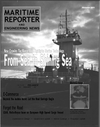
John P. Holland: Father of the Modern Submarine
John Philip Holland was an Irish schoolteacher who immigrated to the United States in 1873 to pursue his passion: the design of the world's first practical submarine. Although never formally trained as an engineer, Holland realized his dream on May 17,1897, with the launching of the Holland VI, the first submarine to combine all of the major systems common to modern submarines in a single vessel. The U.S. Government purchased the Holland VI in April 1900 and commissioned it in October of that year as the USS Holland, the first submarine in the U.S. Navy's fleet. An enhanced Holland design was used for seven more U.S. submarines and was licensed to the U.K., Japan, Russia and the Netherlands, for a total of 24 Hollandtype submarines built in five countries by 1905.
Germany and Sweden also built submarines incorporating Holland's ideas. More than a century later, Holland's basic engineering principles remain the foundation of the world's fleets, and he is generally acknowledged as the father of the modern submarine.
Unfortunately, the historical significance of the USS Holland was not recognized at the time, and it was cut up for scrap in 1932. It was long believed that the destruction of the USS Holland would forever deny historians and engineers the opportunity to study Holland's innovations in detail. Today, however, modern computerized design tools have brought the USS Holland back to life in vibrant 3-D images. Through the magic of Product Lifecycle Management technology from IBM and Dassault Systemes, enthusiasts may tour the ship and operate its major systems, while engineers explore the evolution of Holland's design.
Other stories from November 2002 issue
Content
- Bollinger Restructures Management Team page: 8
- I neat Confirms U.S. Military Contract page: 10
- Promoting A Modal Shift page: 12
- FPSO Farwah Launched at Fene Yard page: 16
- The Irony Of Maritime Security page: 18
- Secure Marine Debuts "Fence" at Sea page: 24
- All Set Tracking Launches New Electronic Seal page: 25
- Additional Funding Urged for Port Security page: 26
- Austal to Build Circle Line's First High Speed Vessel page: 27
- Stena Christens Tanker For Coastal Waters page: 29
- New Fast Craft For Kristiansand City F.D. page: 30
- Gladding-Hearn Delivers Fast Ferry for Lake Erie page: 31
- MTU Engine Series Logs Success on Inland Waterways page: 33
- KMSS Training/Simulation Division Is Buoyant page: 34
- Crowley takes lead with "Reliance" page: 36
- Markey Provides the Strong Pull page: 37
- Lerchbacker Puts Austal USA on the Fast Track page: 38
- Field of Dreams page: 41
- Columbian Rope Continues to Hold Strong... After 175 Years page: 42
- Hydralift Skeg Use Gaining Speed page: 44
- Workboat Annual page: 46
- A New Generation of Fireboats page: 48
- Alstom Selected By Otto Candies page: 50
- TechnoFibre Leads In Lifeboat Maintenance page: 50
- Maritime E-Business Growth Continues page: 52
- Wallem, Drew Team to Offer "Total" Solution page: 59
- Marine Software: Aiming to Lower Costs page: 60
- Full Steam Ahead page: 62
- Marine Data Systems Offers AIS Solutions page: 65
- The Holland Project: Leveraging History to Build Tomorrow's Ships page: 66
- John P. Holland: Father of the Modern Submarine page: 70
- MAN B&W Revises 32/40 Engine page: 71
- RIB Report page: 73
- Willard Ready for Defense, Commercial Contracts page: 75
- Griffon Hovercraft Scores Big Contracts Around the World page: 76
- Wartsila s Italian Plant Rolls Out Two Stroke page: 80
- MAN B&W Touts Proven Tech in New 48/60B Engine page: 84
- Manitowoc = 100 Years of Distinction page: 86
- TankRadar System Breaks New Ground page: 87
- North American Marine Jet Expands Its Market page: 87
- HJ403: Hamilton Unveils New Water jet page: 88

